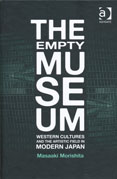
The empty museum, according to Japanese academic Masaaki Morishita, means in the 'West' a museum without an audience. What it means in Japan, he contends, is a museum without permanent displays or curators but instead providing accommodation for temporary exhibitions. The essential argument of this commendably lucid and very well researched study of art museums in Japan is that it is the 'empty museum' in the Japanese sense that corresponds most precisely to the authentic Japanese artistic tradition, rather than merely imitating Western models.
Thus the Tokyo Metropolitan Art Museum, which opened in 1926:
had a character quite distinct from its Western counterparts ... 'emptiness'. The museum, in principle, did not hold any collections, did not employ curatorial staff, and totally relied on temporary exhibitions brought in by external organisations, including art groups and mass media companies. (p. 59)
The Kanagawa Prefectural Museum of Modern Art, opened in November 1951 in the intoxicating dawn of the Japanese postwar economic miracle, was another model, the author states, for an 'empty museum'. It was the first Japanese museum 'of the curator', 'by the curator', 'for the curator' (p. 82). The decision of the curators was that the museum should be 'empty': it should not form its own collection, keep works of art, or 'accommodate any exhibitions brought in by external organisers, including the art groups' (p. 83). What it should do was hold 'themed temporary exhibitions, organised with loan objects', with the specific objective 'to historicise Japanese art after the Meiji period ... and to designate new classics of postwar Japan' (pp. 84, 85). Their decision to make the museum 'empty', Morishita argues, 'was not due to either the curators' ignorance of the collection-based museums or any misunderstanding of Western models'. By contrast, they 'chose not to imitate the Western models, such as the MoMA [New York], because they were fully aware of the particular circumstances Japanese modern art then faced' (pp. 87–8). The most recent manifestation of the phenomenon, according to Morishita, is the spectacular National Art Center Tokyo, which opened in 2007 and is founded on the principle of not having a collection, although it does have curators. This extremely popular institution has become, he claims, 'yet another type of empty museum' (p. 126).
Masaaki Morishita is based at Ritsumeikan Asia Pacific University, and is a visiting researcher at the National Research Institute for Cultural Properties, Tokyo. This book is based on the author's doctoral thesis at the Open University. Theoretically, he engages with Pierre Bourdieu's concept of the artistic field (although it might seem that he does so primarily to demonstrate the irrelevance of most of the theory to the Japanese situation). He also utilises a conceptual framework of transculturation where 'imported Western cultures encountered and interacted with Japanese cultural elements, and new forms of hybrid cultures were generated' (pp. 27–8). Morishita indicates factors that he argues rendered the Japanese artistic scene essentially incompatible with the traditional Western museum formula. Most fundamental was the Japanese art groups — the iemoto system for which there could be 'no room for an intention to surpass the skills and styles developed by the succession of iemoto masters'. Japanese curators were fully apprised of 'the unique power structure of Japanese artistic tradition, virtually independent of the artistic styles and movements of the West' (p. 98). It was the iemoto system that resisted exhibitions and collections cutting across their individual group art histories.
While Morishita gives us fascinating insights into internal art politics in museums in Japan, exemplified by the long battle over many years for control and authority between the curators and artists in his case study of the Tochigi Prefectural Museum of Fine Arts, the 'empty museum' is only part of the story of postwar Japanese art museums. Many Japanese art museums have formed collections. The National Museums of Modern Art in Tokyo, Kyoto and Osaka, for example, have been instrumental in forming a new modern art history in Japan through collections and scholarly curatorial research. Also left out of the discussion is the influence of private museums and their directors, such as the Hara Museum under the eminent Toshio Hara and, more recently, the Mori Art Museum, now under the directorship of Fumio Nanjo, one of Japan's most influential international curators. Many public and prefectural museums have been both innovative and scholarly and their success has depended on curatorial expertise. Examples include the Fukuoka Art Museum, which has been a world leader in collecting and curating contemporary Asian art, and the Saitama Museum of Modern Art. I worked with the director, Masayoshi Homma, at the latter institution in the 1980s on a series of exchange exhibitions of contemporary Japanese and Australian Art and the model of co-curatorship we developed underpinned the early Asia-Pacific Triennial exhibitions at the Queensland Art Gallery. While the National Art Center may provide space for art groups, its real popularity and purpose is curated exhibitions such as the immensely popular Emily Kngwarreye exhibition developed by the National Museum of Australia and curated by Margo Neale, in association with Professor Akira Tatehata, director of the National Museum of Modern Art, Osaka, and one of the most distinguished art scholars in Japan. Most museums in Japan, as Morishita himself states, developed a hybrid model where curators were employed and in many cases collections formed. It is his contention that about half of the 60 prefectural art museums founded in Japan in the postwar period operate on a hybrid model with local artists controlling their own exhibitions and the museum's curators working on the permanent collection and temporary exhibitions based on their curatorial research. Many of the internationally renowned Japanese art museums, while they may have developed distinctly Japanese characteristics different from the West, did not necessarily follow the 'empty museum' model. Morishita's book is, nonetheless, a most significant contribution to museum and art studies about Japan, and to museology internationally, in revealing the way that Japanese art museums have adapted Western models to suit their own society.
